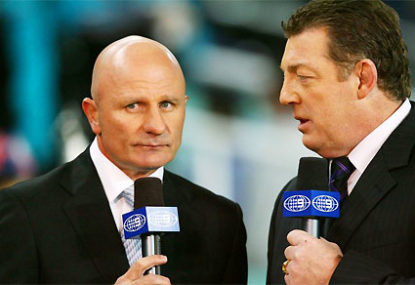Barien9
new author
Roar Rookie

“When you cannot place yourself in the consumer’s shoes, you may have lost complete perspective on your business goals.” – Matthew Johns on Fox, 22/8/12.
The first point that needs to be addressed is the pressure that had been placed on the commission. Many analysts and journalists placed so much emphasis on John Grant’s billion-dollar TV rights figure that just $1 less than this wonderful number would have been considered a failure.
Hypothetically, there are two ends of the measuring sticks: a high figure for TV rights and complete consumer satisfaction. Essentially, there is an inverse relationship between the two. The reason for this inverse conflict is because TV stations would ideally love to broadcast games in a compromised fashion.
They’d prefer to have all games delayed, to allow for ads. They want all games broadcast in prime time in order to attract a greater audience. They desire a maximum number of breaks in play (i.e. scrums, penalties, etc.) to allow for ads. They also want exclusive rights to the NRL.
NRL fans, however, would love to have games broadcast in a contrasting manner. Supporters obviously want to have all games broadcast live and free to air. Most people would prefer more afternoon games, allowing for them to work the next day, cater for family commitments, etc.
As you see, there is obviously a complete conflict between the two. It can be said neither of these situations can be implemented, but the commission where given the duty of finding a deal somewhere in between that achieves enough money for the game, while furthering the rugby league experience.
From above it can be understood, since Grant needed to achieve a billion dollar mark, the scale has been shifted heavily towards the TV stations’ ‘perfect world’.
There’s no doubt in terms of revenue streams for TV stations, AFL is better than NRL. This is mainly due to the length of the game and various natural breaks (I believe it’s one or two per goal), plus more ‘manufactured’ breaks of four quarters instead of two halves.
Ultimately the NRL achieved more or less the same figure as the AFL (the NRL still don’t have a mobile platform, for which AFL received about 160 million), but in doing this the AFL didn’t have to sacrifice as much to the consumer experience. In fact, they extended it.
Three initiatives were key to the AFL deal. Firstly, three live games, free to air, plus one delayed. Secondly, all live games for paid television subscribers and thirdly, live game for those teams in their home state.
It needs to be understood that in the short-term, while it may sound good to the administrators and players for their now secure jobs, NRL fans have been left with essentially the same package and the fan experience has been diluted. There are no more live games and no more games for free to air TV, which would have allowed the game to expand to the consumer who right now doesn’t follow NRL.